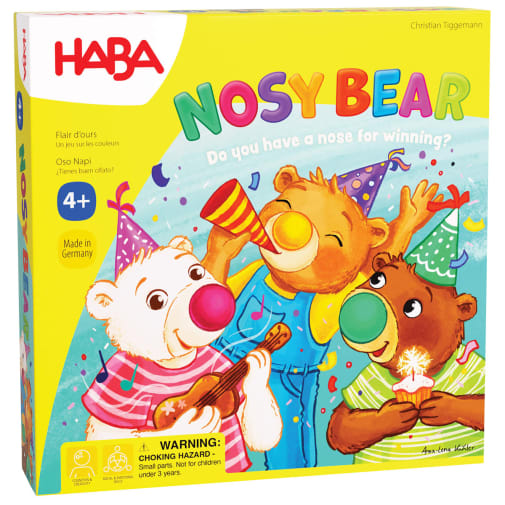The cutest little bear game – with colorful, high-quality wood pieces! Kids learn to follow rules, take turns, and think ahead! As wooden Yuki Bear hops from one bear friend to another, players place their bear cards over the wooden bear noses of the same color, trying to be the first to play all their cards. But watch out! Things don’t always go the way we think at these bear parties! Simple rules allow family and friends to start playing immediately, and one round of the game takes only about 10 minutes. Such a fun way to connect and make memories together!
Nosy Bear Game
SKU
038443
Grade PK-3
These icons are designed to help you quickly understand and learn important information about our products.
Teaching Method
Traditional
Teacher-centered curriculum commonly used in classrooms that may include a text, teacher manual, tests, etc.
Charlotte Mason
A methodology based on the work of a 19th century educator who maintained that children learn best from literature (Living Books), not textbooks.
Classical
A methodology based on the Latin Trivium (three stages of learning), including the grammar stage (memorization and facts), logic stage (critical thinking), and rhetoric stage (developing/defending ideas).
Unit Study
A thematic or topical approach centered around one topic that integrates multiple subject areas.
Montessori (Discovery)
A methodology based on the work of a 20th century educator that emphasizes student and sensory-driven discovery learning and real-life applications.
Other
Other methodologies
Religious Content
Secular
Contains content contrary to common Christian beliefs (i.e. evolution).
Neutral
Avoids religious or theoretical topics or presents multiple viewpoints without preference.
Christian/Religious
Faith-based or including instructional religious content.
Learning Modality
Auditory
Learns through listening, talking out loud or reading out loud.
Visual
Learns through seeing, prefers written instructions and visual materials.
Kinesthetic/Tactile (Hands-On)
Learns through moving, doing and touching.
Multi-Sensory
Curriculum that employ a variety of activities/components.
Presentation
Sequential
Curriculum progresses through well-defined learning objectives. Emphasizes mastery before moving to the next topic.
Spiral
Topics and concepts are repeated from level to level, adding more depth at each pass and connecting with review.
Conceptual/Topical
Focus is on the “why,” often with a unifying concept as well as specific skills; coverage may be broader.
Teacher Involvement
Low Teacher Involvement
Student-led materials; parent acts as a facilitator.
Medium Teacher Involvement
A mix of teacher-led time and independent student work.
High Teacher Involvement
Teacher-led lessons; may utilize discussions, hands-on activities and working together.
Additional Materials Required
No other materials needed
Everything you need is included.
Other Materials Required
There are additional required resources that are a separate purchase.
Other Materials Optional
There are additional resources mentioned or recommended but are not absolutely necessary.
Consumable
Consumable
Designed to be written in; not reusable.
Non-Consumable
Not designed to be written in; reusable.
Our Price
$19.99 Description
Publisher's Description of Nosy Bear Game
You are invited to a party! In Nosy Bear Game children join Yuki Nosy Bear and his friends for a colorful and exciting party adventure. At Yuki Nosy Bear's big party, he welcomes a variety of creatively dressed bear friends like the green “Goosebear” and the red “Strawbear.”
Children will love hopping Yuki Nosy Bear from one guest to another, creating a dynamic and interactive play experience. The first player to put down all their bear cards wins, adding an element of excitement and competition.
- Vibrant Components: The game includes 1 Yuki Nosy Bear, 8 wooden colored noses, 24 bear cards, 1 party hat, 1 die, 6 gift tiles (including 2 spares), and 1 rulebook. Each component is designed with bright colors and high-quality materials to ensure durability and appeal.
- Educational Value: Beyond fun, the game encourages strategic thinking, social interaction, and fine motor skills, making it a valuable addition for parents seeking educational toys.
Details
| Product Format: | Other |
|---|---|
| Grades: | PK-3 |
| Brand: | HABA |
| EAN/UPC: | 4010168280851 |
| Length in Inches: | 8.625 |
| Width in Inches: | 8.625 |
| Height in Inches: | 1.875 |
| Weight in Pounds: | 1.55 |
Videos
Reviews

